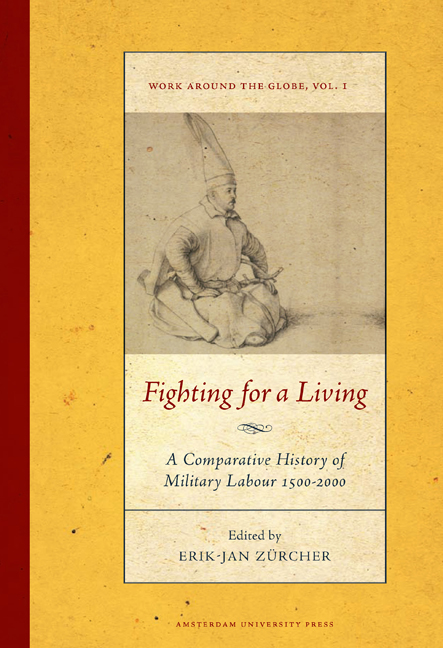Book contents
- Frontmatter
- Dedication
- Contents
- Preface
- Introduction: Understanding Changes in Military Recruitment and Employment Worldwide
- Military Labor in China, c. 1500
- From the Mamluks to the Mansabdars: A Social History of Military Service in South Asia, c. 1500 to c. 1650
- On the Ottoman Janissaries (Fourteenth-nineteenth Centuries)
- Soldiers in Western Europe, c. 1500-17901
- The Scottish Mercenary as a Migrant Labourer in Europe, 1550-1650
- Change and Continuity in Mercenary Armies: Central Europe, 1650-1750
- Peasants Fighting for a Living in Early Modern North India
- “True to Their Salt”: Mechanisms for Recruiting and Managing Military Labour in the Army of the East India Company During the Carnatic Wars in India
- “The Scum of Every County, the Refuse of Mankind”: Recruiting the British Army in the Eighteenth Century
- Mobilization of Warrior Populations in the Ottoman Context, 1750-1850
- Military Employment in Qing Dynasty China
- Military Service and the Russian Social Order, 1649-1861
- The French army, 1789-1914: Volunteers, Pressed Soldiers, and Conscripts
- The Dutch Army in Transition: From All-volunteer Force to Cadre-militia Army, 1795-1830
- The Draft and Draftees in Italy, 1861-1914
- Nation-building, War Experiences, and European Models: The Rejection of Conscription in Britain
- Mobilizing Military Labor in the Age of Total War: Ottoman Conscription Before and During the Great War
- Soldiering as Work: The All-volunteer Force in the United States
- Private Contractors in War From the 1990s to the Present: A Review Essay
- Collective Bibliography
- Notes on Contributors
Soldiers in Western Europe, c. 1500-17901
Published online by Cambridge University Press: 12 December 2020
- Frontmatter
- Dedication
- Contents
- Preface
- Introduction: Understanding Changes in Military Recruitment and Employment Worldwide
- Military Labor in China, c. 1500
- From the Mamluks to the Mansabdars: A Social History of Military Service in South Asia, c. 1500 to c. 1650
- On the Ottoman Janissaries (Fourteenth-nineteenth Centuries)
- Soldiers in Western Europe, c. 1500-17901
- The Scottish Mercenary as a Migrant Labourer in Europe, 1550-1650
- Change and Continuity in Mercenary Armies: Central Europe, 1650-1750
- Peasants Fighting for a Living in Early Modern North India
- “True to Their Salt”: Mechanisms for Recruiting and Managing Military Labour in the Army of the East India Company During the Carnatic Wars in India
- “The Scum of Every County, the Refuse of Mankind”: Recruiting the British Army in the Eighteenth Century
- Mobilization of Warrior Populations in the Ottoman Context, 1750-1850
- Military Employment in Qing Dynasty China
- Military Service and the Russian Social Order, 1649-1861
- The French army, 1789-1914: Volunteers, Pressed Soldiers, and Conscripts
- The Dutch Army in Transition: From All-volunteer Force to Cadre-militia Army, 1795-1830
- The Draft and Draftees in Italy, 1861-1914
- Nation-building, War Experiences, and European Models: The Rejection of Conscription in Britain
- Mobilizing Military Labor in the Age of Total War: Ottoman Conscription Before and During the Great War
- Soldiering as Work: The All-volunteer Force in the United States
- Private Contractors in War From the 1990s to the Present: A Review Essay
- Collective Bibliography
- Notes on Contributors
Summary
Particularly after the second half of the seventeenth century, when armed forces grew exponentially, armies typically ranked as the largest single employers within states. Thus, soldiers constituted the most numerous unified labour force within Europe. A consideration of troops within the framework of labour history is accordingly both appropriate and also long overdue, especially since in certain circumstances soldiers acted very much like modern workers. For example, it would not be out of line to regard military mutinies as among the largest and most effective strikes in European history before the emergence of labour militancy associated with the Industrial Revolution. However, generalizations about soldier-labour in Europe during the early modern period – taken here to encompass those decades falling roughly between 1500 and 1790 – have to be advanced cautiously and hedged around with caveats. This is for three principal reasons. First, there was considerable variety of practice both within and between polities with regard to the employment of soldiers, which makes generalization hazardous. Secondly, the period was characterized by considerable changes of practice. To be sure, the notion that these changes constituted a “military revolution”, at least in the format originally proposed by Michael Roberts in the 1950s and subsequently amended by Geoffrey Parker, has been challenged and rejected by many specialists. But the debate over the “military revolution” has emphasized the extent of the changes that were taking place, though these occurred over a much longer timeframe than Roberts and Parker envisaged, and lay as much in the areas of state development, the economy, and the management of armies, for instance, as in the realms of weaponry, drill, and tactics. This chapter will seek to do justice to these changes in the space available without misrepresenting the reality of complex and uneven developments. Thirdly, precisely because the exploration of soldier-labour is so important and almost unprecedented, the effort must be undertaken with care so as to avoid distorting categories and conclusions by imprudently constructing generalizations about military labour from the study of the civilian workforce or by too freely imposing concepts generated by modern labour studies onto an earlier era. As military institutions and practices are incorporated within a broader labour history, it is important to respect the integrity of the military past.
- Type
- Chapter
- Information
- Fighting for a LivingA Comparative Study of Military Labour 1500–2000, pp. 135 - 168Publisher: Amsterdam University PressPrint publication year: 2013
- 2
- Cited by

